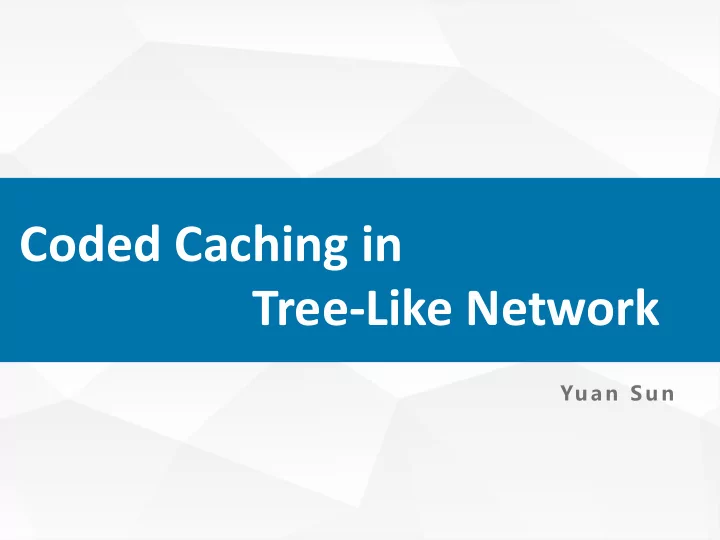

Coded Caching in 我们毕业啦 Tree-Like Network 其 实 是 答 辩 的 标 题 地 方 Yu an Su n
Introduction Problem Setting Main Results CONTANTS Discussion
I n t r o d u c t i o n “ What is the cache? caching is a necessary and useful technique to balance the traffic load over the network. In the idle period, the content of the caches will be updated, and when user request the file that is cached locally, then the request will be satisfied without transmission with the base station. What is coded caching? In placement phase, each file in the base-station is divided into several sub-files and cached in every user. In delivery phase, the network is usually congested and some sub-files are delivered from the server to the users to reconstruct the re- quested files with the content of the cache. What is discussed today? In practice, many caching systems consist of not only one but multiple layers of users equipped with a cache, usually arranged in a tree-like ” hierarchy with the origin server at the root node and the users as the leaves and some transfer station.
i n t r o d u c t i o n Centralized Decentralized
P r o b l e m S e t t i n g The tree-like structure of coded caching scheme with N=5, K=5, M=2 and four layers. The black block means the server holding whole files; blue blocks mean transfer station without caches; green blocks mean users, each equipped with a cache. In placement phase, for instance, the file A is split into A12, A13, A14, A15, A23, A24, A25, A34, A35, A45 and the caching strategy is Z1=(A12, A13, A14, A15, B12, B13, B14, B15, C12, C13, C14, C15, D12, D13, D14, D15, E12, E13, E14, E15) During the whole process, the total trans- mission rate can be calculated as 69/10, com- pared with the un-coded caching scheme of 114/10, reduced by 9/2.
M a i n r e s u l t s ( c e n t r a l i z e d ) Theorem 1 In centralized coded caching scheme, there are N files in server, with K users mapped ̆into different layers, each equipped with a cache memory of M. Regards to one specific layer, there are total x users above this layer, so the trans- mission rate to the transfer station is
M a i n r e s u l t s ( c e n t r a l i z e d ) Theorem 2 Compared with un-coded caching scheme, the gain obtained from coded caching scheme is and with deeper level of the system, the average gain per user is reduced. Use ∆ dominating the average gain per user and it can be expressed as
M a i n r e s u l t s ( d e c e n t r a l i z e d ) The tree-like structure of coded caching scheme in decentralized setting with N=4, K=4, M=1 and three layers. For the channel1, the packets are transferred are For the channel2, the packets are transferred are For the channel3, we can get the same result. The packets are transferred are
M a i n r e s u l t s ( d e c e n t r a l i z e d ) Theorem 3 In decentralized setting, at every transfer station, dropping unneeded packets, it can still use the decentralized coded caching to delivery to the next transfer station. Specifically, every channel’s transmission rate between transfer stations is
M a i n r e s u l t s ( d e c e n t r a l i z e d ) Assuming that in terms of one specific layer, there are K+L users above this layer and there are K users remained, the packets transferred form the above layer is possessed by dropping the unneeded packets. According to the algorithm of the decentralized setting, the dropped packets are listed in the table1.Therefore
M a i n r e s u l t s ( d e c e n t r a l i z e d ) ∆ R actually is just possessing the delivery phase to L users, and what different is that the size of packets is larger (1 − M ) K . Therefore,
D i s c u s s i o n “ An interesting extension of the coded caching approach proposed in this paper to device-to- device networks without a central server is considered. Adapting coded caching to D2D network and analyzing the performance of the scheme, such as lower bound and upper bound, is also worth researching. Designing computationally efficient coded caching schemes which are scalable to large systems is of great interest. ”
Q&A
THANKS Yuan Sun
Recommend
More recommend